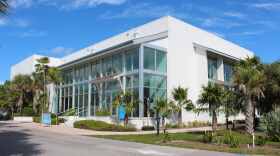He's been gone for more than half a century, but the works of master architect Frank Lloyd Wright live on. And, for the first time in 66 years, a new home by Wright is being built. It's being unveiled tonight as a portal for tourists visiting the largest collection of Wright's works anywhere.
The hand of Frank Lloyd Wright is unmistakeable. His design is low to the ground, blending with its surroundings.
This "organic" architecture features bands of horizontal lines, built with textile blocks - simple designs with rich detail. Floor to ceiling windows let natural light flood inside. Playfully arranged glass blocks sprinkle bits of back-lit color.
BAKER: One of the things about this house is you have to imagine is the impact it would have had in 1938, when it was designed. But many of the things he designed in 1938 are now taken for granted - the open floor plan, the floor to ceiling windows. And those types of ideas really happened for the first time during this period.
That's Jeffrey Baker, the lead architect on the project. He's traveled south from his Albany, New York-based firm to attend the grand opening.
The home that's being constructed was designed by Wright for faculty housing on the Florida Southern College campus. Even though it was designed in 1939, the house still has an ultra-modern, even futurist feel. Baker says after all these years, his work still looks like it's landed from the pages of science fiction.
BAKER: It's not something that people may understand, when they see it, but Frank Lloyd Wright wanted us to see it within ourselves to really understand his architecture, to really question our own precepts and what's been given us in the world, and the forms that have been given us in the world, and not take them for granted. Just to keep questioning our own environment, and try to create an environment that resonates with our souls.
Wright's works are a major tourist attraction on this campus, which is perched on a steep hill overlooking Lake Hollingsworth. Rob Tate, a vice president at the college, expects the new Wright-built tourism center to be another big draw.
TATE: We have 30,000 people a year who come to visit just the Wright collection on this campus. And with the advent of this new center, we think we can raise it to 100,000 in two years. And that's a direct economic impact in local spending of $1.7 million annually. REPORTER: There's a big financial consideration here. Do you think you need more money for the upkeep of these older buildings, which cost a lot of money? TATE: Our goal is to take the profits from the tours and the visitor's center and the things we sell in the gift shop, and put that back into the ongoing restoration of the original campus.
Florida Southern College President Anne Kerr says the popularity of Wright's work has ebbed and flowed in the past in the U.S., but overseas he has always been a big hit with architecture fans.
KERR: I think there will always be, though, this group of cultural tourists and those who are interested in art and architecture, who appreciate the genius of Wright. And actually, there's been a resurgence of interest in his work. And so they have seen spikes in attendance at Taliesin, Fallingwater, Taliesin West and all the other Wright locations. So we hope we can capitalize on that and become one of the top 10 cultural destinations in the United States.
Even though Kerr's vision of cracking the top 10 cultural draws might be be a dream, the architect, Baker, has his own vision of what Wright has wrought.
BAKER: I feel it's almost like a dream. I've had this feeling once before, when I visited Fallingwater - which is considered to be Frank Lloyd Wright's greatest work - but he really drives home how wonderful a piece of sculpture can be, and how architecture and sculpture can come together. I think Wright was able to achieve that perhaps better than any other architect who has ever lived.
Having Wright's mystique and a "solid financial footing" come together is what Florida Southern officials envision. Restoring those buildings - including Wright's iconic 1941 Annie Pfeiffer Chapel - will cost more than $50 million.






